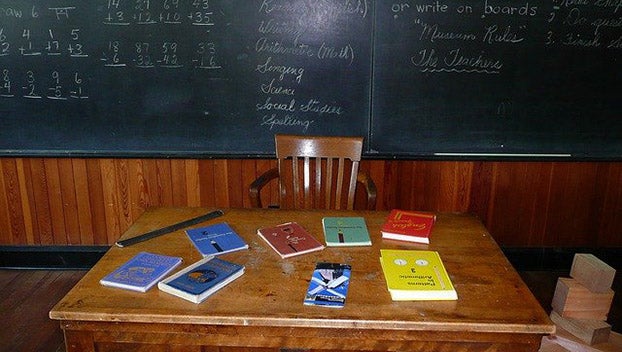School districts deal with teacher shortages
Published 8:30 am Thursday, September 15, 2022
|
Getting your Trinity Audio player ready...
|
By Brian Carlton and Crystal Vandegrift
The K-V Dispatch
One month into the new semester, schools in Lunenburg County still have a teacher shortage.
We are currently about a dozen teachers short across our division,” said Meri Page Spencer, the district’s public relations coordinator. “We are advertising to fill those positions.”
It’s a problem for many Virginia school districts right now. In this region, Prince Edward County has 10 vacancies. Buckingham and Cumberland also have positions left to fill. And the news isn’t much better across the state, where there are an estimated 1,200 vacant teacher positions.
“This is a nationwide problem and Cumberland is not immune,” said Dr. Chip Jones, Superintendent of Cumberland County Public Schools. “We had quite a few openings and very few applications, although many of our recent hires have been extremely qualified.”
Currently, Jones needs to fill five positions. The district is looking for a senior instructor for JROTC, a high school health and physical education teacher, a dual enrollment chemistry teacher, a dual enrollment physics teacher and a middle school teaching and learning facilitator.
But what’s causing the drop in applicants? And will Gov. Glenn Youngkin’s new plan have an impact?
WHAT’S CAUSING THE TEACHER SHORTAGE?
There are a few things causing the shortage, based on a survey by the National Education Association. Part of that comes due to salary. Virginia teachers make an average of $58,506, according to the National Education Association. That puts the Commonwealth 25th in the nation. An average starting teacher’s salary in Virginia comes in at $42,251, good enough for 18th. The national average, by comparison, is $65,293.
Another issue, both in this region and across the state, is burnout. The NEA study found Virginia teachers are quitting (and prospective applicants staying away) partly due to increasing expectations and requirements. They’re being asked to do more with the same amount of resources, same time involved and same pay.
“Finding a nurse or carpenter or a computer programmer who wishes to leave the private sector to teach for teacher pay is difficult to say the least,” the NEA report states. “Many teachers have been retiring from teaching after they reach that 30-year mark, even though they are not yet 65.”
RECOMMENDATIONS
To fix the teacher shortage, the report recommends a couple things. First, they suggest bringing back retired teachers who are willing to help. The problem with that in the past has been about benefits. If a Virginia teacher unretires, they lose their Virginia Retirement System benefits. The NEA suggests letting retirees come back while being able to keep benefits.
The report, and some local superintendents, also suggest the state needs to make it easier to become a teacher.
“There are many requirements for earning a teaching license in Virginia,” said Charlotte County Public Schools Superintendent Robbie Mason. “Removing some of those barriers and replacing them with alternative licensure routes will be beneficial.”
JONES SUGGESTS ANOTHER OPTION.
“What would help the most? Increasing teacher salaries would be a good start as well as ensuring that benefits, such as health insurance, are affordable,” said Jones. “While salary is not always the most important reason for remaining with their organization, it is always a major factor.”
Jones points to a report from global analyst group PwC called Workforce of the Future. That report showed 44% of millennial employees feel salary is important when it comes to attracting talent, second only to career development.
“We lost several teachers who went to other divisions because they paid substantially more than (Cumberland),” Jones said. “It is also disheartening when teachers look at the salary scale and see such a small difference between their starting pay and what they will be paid 30 years down the road.”
While it doesn’t address salary, a new proposal by Virginia’s governor could help speed up how quickly new teachers get licensed.
YOUNGKIN’S PROPOSAL
On Thursday, Sept. 1, Gov. Youngkin signed an executive directive to help with the shortage.
Mason’s suggestion about changing the licensing process is part of that.
Under the new directive, Virginia’s Secretary of Education Aimee Guidera is being assigned to work with the Superintendent of Public Instruction, Secretary of Finance, Secretary of Labor and the Commissioner of the Department of Labor to rework how teachers are licensed. Specifically, the order says the group is to “reduce red tape associated with teaching licensure, while ensuring high standards, in order to recruit more out of state teachers, retired teachers, career switchers, military veterans and other professionals with much to offer students.”
Multiple superintendents praised another part of the order which creates a registered teacher occupation apprenticeship program. School divisions like Prince Edward and Buckingham would work with the state to help train and license new teachers, including those already working as paraprofessional educators. A paraprofessional is someone already in the classroom as an assistant.
They don’t lead lessons for the class and they’re required to be supervised by a licensed teacher. Under this plan, it would be easier and quicker for those “parapros” to earn their full license.
But while they support the pieces in the order, superintendents remind people that this isn’t a problem that’s quickly fixed.
TEACHER SHORTAGE NOT A SIMPLE PROBLEM
“This is not a simple problem with a simple solution,” Jones said. “For example, the Governor’s Executive Directive calls for the Superintendent of Public Instruction to provide flexibility in issuing teaching licenses for teachers from out of state and renewal of licenses which may have lapsed.”
He also said that cutting red tape for licensing would be a benefit when trying to get certain types of instructors, like building trades teachers.
But then he said there are parts of the directive that while they sound great, need teacher support to actually work.
Part of the directive requires schools to take part in an annual survey. Each year, all returning teachers will take part in a survey, identifying what works and what doesn’t. The same goes for exiting teachers, who will be asked to identify the main causes of why they’re leaving the profession.
“Last year, a new survey was put in place,” Jones said. “This report required teachers leaving a school to select up to three of 17 reasons for leaving. A well-known bias for surveys is ensuring accurate and honest responses. More reporting of this type may not be the answer, but could provide additional insight.”
Jones and other superintendents also caution that it will take time to see things change.
“There is not an overnight fix to the teacher shortage, but every family and child is counting on all of us to continue to collaborate and find solutions,” Jones said. “The future depends on it.”



